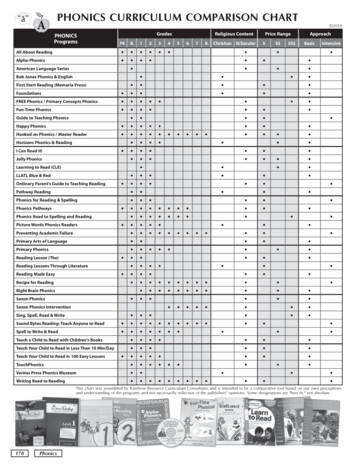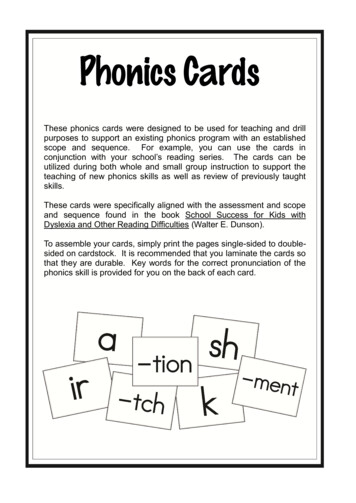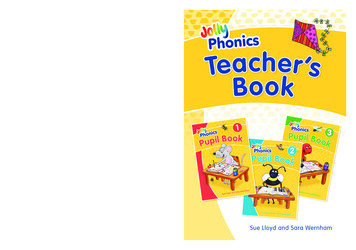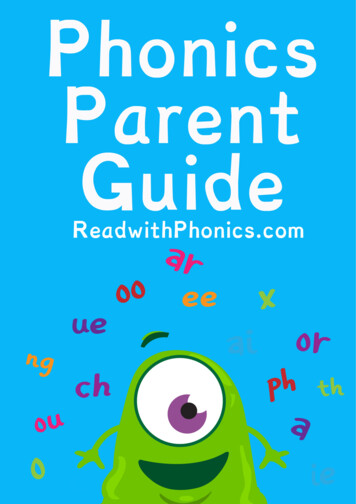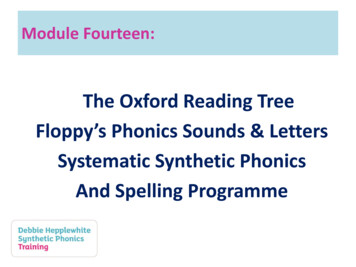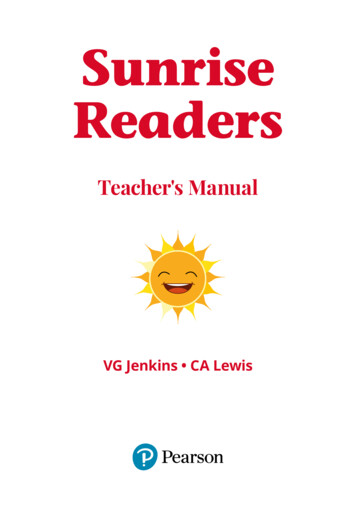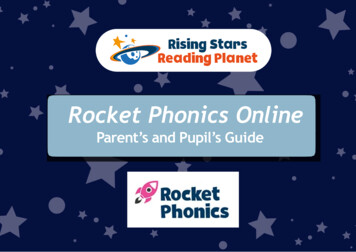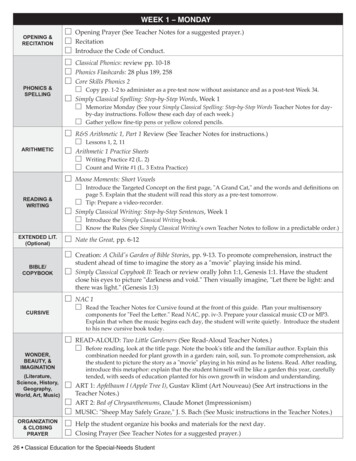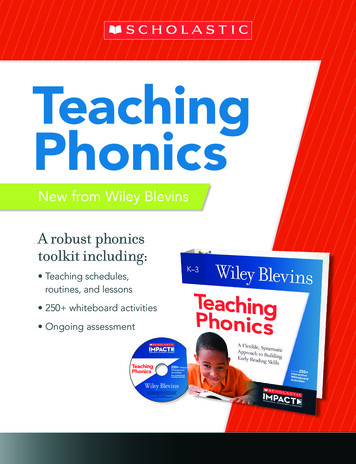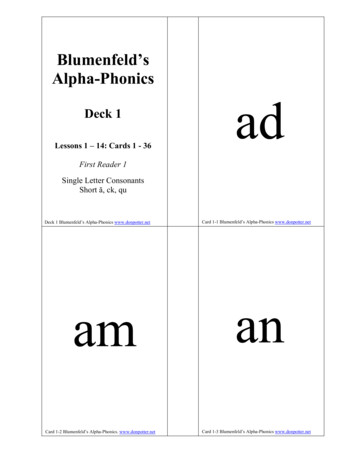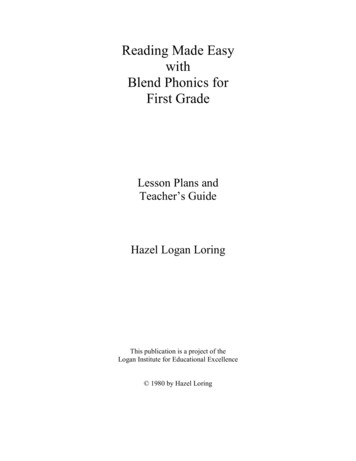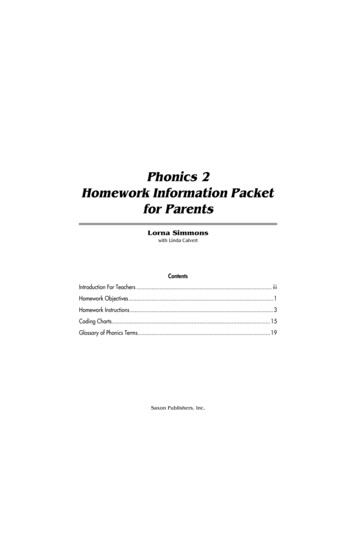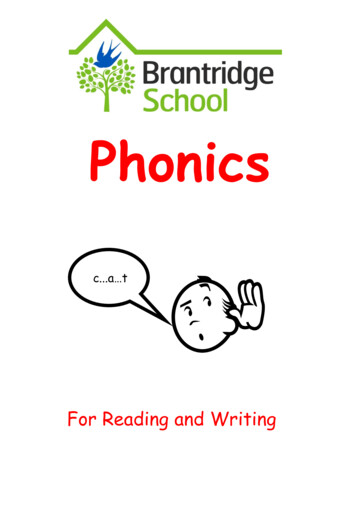
Transcription
Phonicsc.a tFor Reading and Writing
A phoneme is the smallest unit of soundof spoken language When the ‘phonemes’ are combined,they make the words that we speak Sounds are made in the throat andmouth Sounds are made from the movement ofmuscles in the throat, face, mouth andtongue Sounds are made from vibration and /or the movement of air
There are approximately 44 phonemes(units of sound) in the English language These phonemes are represented inwritten English by graphemes (lettershapes) Each phoneme may be represented by asingle letter, a diagraph (2 letters) ortrigraphs (3 letters) A few phonemesare represented by 4 or more letters Some phonemes are represented in avariety of ways this is one reason why learning to read andwrite the English language is more trickythan other languages – there is more thanone way to ‘spell’, or represent, some of thephonemes
Children need to be able to makedifferent sounds in order to be able tospeak. They learn to speak by hearingand copying those around themTo move onto learning the link betweenspeech and written language Children need to be able to distinguishand discriminate between one sound andanother – they need to be able to hearthe different phonemes Early provision – lots of talk / singing /chanting, making sounds, using themouth / tongue etc, hearing differentsounds, spotting the differencebetween a range of sounds
1. Hear the phoneme2. Say the phoneme3. Learn the letter(s) that represent nise theletters in print andlink with phonemesWrite the letterswhich represent thephonemeSegment and Blendphonemes to readthe wordSegment a wordinto its phonemesand represent withletter(s)
Hearing and saying the phonemeInitial – at the beginning of a wordstrong phonemesmedial (middle) and final phonemesLearning the letter(s) that represent the phonemeVisual image of letter(s) linked with phonemeSegmenting and blending – Decoding written wordsSaying a word, counting the phonemes (sound buttons /fingers) blending together to say the word again and readitSegmenting and blending – Encoding to write wordsSaying a word, counting the phonemes (sound buttons /fingers) writing the grapheme to represent thephonemes. Writing is phonetically plausible e.g. writtenhow it sounds outSpelling –Learning spelling patterns and word families along with Keyword / High frequency words
WordPhonemes1.Sayit2. Count the phonemes3.Blend to saythe wordReading Blend to readthe wordWriting –Representeach phonemewith retchstretchsprintsprintflickflick
PurposeWe must knowwhat we areteaching andhow thisbuilds on whatthey learntpreviouslyParticipationPaceThe adult modelsa passion forwhat they areteaching. If wedon’t get excitedabout phonics thechildren won’teitherChildren need tobe activelyinvolved (notsitting passively)PraiseChildren do bestwhen they arepraised for theirefforts and whentheir learning iscelebratedThe adultdirects thesession. It ispacey andpurposeful.Passion
Resources /ideas that we use from each schemeThere are different schemes forteaching phonics although what childrenhave to learn in each scheme is the sameSome schemes available JollyphonicsPhonicsflashcards anddisplay friezes.Sound matsActions andsongsPace of scheme(1 sound per day)And Alpha to OmegaLettersandSoundsPlanning – thisscheme includesdifferentspelling patterns(ai/ay/a e)Read,WriteIncSpeed soundsgrid‘Flashcards with‘ditties’(memorableWord flashcards phrases withwith ‘soundpictures to helpbuttons’learn thesounds)
Early stages – hearing and discriminating sounds andlearning the letter(s) that represent the phonemesChildren do phonics in ability groups1. Set expectation for the session‘Everyone eyes this way. I am looking for super star listeners.Great we are all ready.’2. Review - Quickly review previous learning‘Yesterday we learnt ‘oa’ words. Let’s see how many ‘oa’ words wecan segment then blend.3. Speedy phonics flashUse the speed sounds grid or a set of phonics flashcards.4. Teach - Share the purpose (new learning objective)We are going to learn the ‘ch’ sound it has 2 letters that make onesound.5. Practise blending lots of words using the new soundUse the letters and sounds ‘sound button’ flash cards or simplywrite a list of appropriate words on a portable whiteboard.
Phase 3Week 1Focus phonemes: ch, sh, th, ng, aiBank ofwordsch – chin, chug, check, such, chip, chill, much, rich, chicken.sh – ship, shop, shed, shell, fish, shock, cash, bash, hush, rushth – them, then, that, this, with, moth, thin, thick, path, bathng – ring, rang, hang, song, wing, rung, king, long, sing, ping-pongai – wait, hail, pain, aim, sail, main, tail, rain, baitDitties(use thesewith readwrite incpictureflashcards)ch (bouncy sound) – “ch, ch, choo!” The horse sneezes as the caterpillars hairs get uphis nosesh (stretchy sound) – “shhhh” says the horse to the hissing snaketh (stretchy sound) – The princess in the tower is rescued by the horse she says“thhhhankyou”ng (stretchy sound) – “nnnng - A thing on a string”ai (stretchy sound) - “snail in the rain”ReviewSet of phase 2 flash cards (cvc words)Practise segmenting and blending 6-10 words.PhonicsflashUsing the speed sounds grid / flash cards practise saying each digraph /trigraph withthe children.Model the ‘pure’ sound and get chn to repeat and practise as necessary.TeachHold up the ch flashcard and say ‘ch’Show chn the jolly phonics action / say the Read Write Inc ‘ditty’ and look at thematching picture flashcardch has two letters that make one soundModel saying the sound clearly then point to the chn to make the sound. Do thisseveral times at a quick pace.PractiseBlendingI blend, we blend, blend to a partner.The teacher starts by segmenting and then blending a word ch/i/n chin.The chn do this with the teacher, then the chn turn to their partner and each have ago at doing this. They quickly turn back to the teacher for the next word.SegmentingTeacher says- “The word is chip.”Children say- “ch-i-p” (they use their fingers to mark the sounds, using two fingersfor the digraphs)Repeat for other ch words
How do we teach phonicsat Brantridge?Phases of phonics – learningoutcomesPhase 1 Explore and experiment with sounds and words Listen attentively Show a growing awareness and appreciation of rhyme,rhythm and alliteration Speak clearly and audibly with confidence and control Distinguish between different sounds in words Develop awareness of the differences between phonemesPhase 2 Children know that words are constructed from phonemesand that phonemes are represented by graphemes They have knowledge of a small selection of commonconsonants and vowels taught in sets. They blend them together in reading simple CVC words andsegment them to support spelling.Phase 3 Children link sounds to letters, naming and sounding theletters of the alphabet. They recognise letter shapes and say a sound for each. They hear and say sounds in the order in which they occurin the word, They read simple words by sounding out and blending thephonemes all through the word from left to right. They recognise common digraphs and read some highfrequency words.
How do we teach phonicsat Brantridge?Phases of phonics – learningoutcomesPhase 4 Children are able to blend and segment adjacentconsonants in words They apply this skill when reading unfamiliar texts and inspellingPhase 5 Teaching children to recognise and use alternative ways ofpronouncing the graphemes and spelling the phonemesalready taught(Mean /Bread)Phase 6 Moving into spelling strategies and skills Plurals Suffixes Prefixes Past tense ed/ing
How do we teach phonicsat Brantridge?Phases of phonicsChildren in phases 1 and 2 will be in the earliest stages of theirphonic development. They will be working from phase 1 and 2 ofthe ‘Letters and sounds’ programme.Phase 1Lots of talk / singing / chanting, making sounds, using the mouth/ tongue etc, hearing different sounds, spotting the differencebetween a range of soundsActivities in this phase will run alongside phase 2 and be used toembed the sounds taught.Phase 2Rate of sound introductionIt is recommended that the letter sounds are introduced at therate of one letter sound every day. All 44 letter sounds areintroduced at this rate so that they have been covered in about9 weeks. Recapping from prior session to be undertaken daily.Progression in phase 2 (one sound per day)Set 1:Set 2:Set 3:Set 4:Set 5:Set 6/7:sigckhjanoebvtmcuf/,ffwpdkrl,/llxssyquz/zzAs well as learning the above phonemes children will be blendingphonemes to read VC/CV (if, on, is/no, go, so) words and they willbe segmenting VC/CV words to spell.They will be blending and segmenting CVC words
How do we teach phonicsat Brantridge?Phases of phonicsPhase 3 In this phase you will teach another 18 phonemes, most of themcomprising two (digraph) or three (trigraph) letters. The children will represent each of about 44 phonemes (thosetaught in phases 2 and 3) by a grapheme. Children also continue to practise CVC blending andsegmentation and will apply their knowledge of blending andsegmenting to reading and spelling simple two-syllable words andcaptions. They will secure letter names during this phase, learn to readtricky words and also learn to spell some of these words.Progression in phase 3 (one sound per day)ch, sh, th, ng, aiee, ie/igh, oa, oo/oo, aror, ur, ow, oi, erear, air, ure, ire
How do we teach phonicsat Brantridge?Phases of phonicsPhase 4Children entering Phase Four will be able to represent each of44 phonemes by a grapheme, and be able to blend phonemes toread CVC words and segment CVC words for spelling.They will have some experience in reading simple two-syllablewords and captions.They will know letter names and be able to read and spell sometricky words.The purpose of this phase is to consolidate children’sknowledge of phonemes/graphemes in reading and spellingwords that contain adjacent consonants and polysyllabic words.Words learnt in this phase may follow the patterns below CVCC words, CCV and CCVC words, CCVCC, CCCVC and CCCVCCwordsLists of words are available in the letters and soundsdocumentation.
How do we teach phonicsat Brantridge?Phases of phonicsPhase 5 Children entering Phase Five are able to read and spell wordscontaining adjacent consonants and some polysyllabic words. The purpose of this phase is for children to broaden theirknowledge of phonemes and graphemes for use in reading andspelling. They will learn new graphemes. Some of the alternatives willalready have been encountered in the high-frequency words thathave been taught. Children become quicker at recognising digraphs and trigraphsand at blending the phonemes they represent. When spelling words they will learn to choose the appropriategraphemes to represent phonemes and begin to build wordspecific knowledge of the spellings of words.
How do we teach phonicsat Brantridge?Phase 6Phases of phonics By the beginning of Phase Six, children should know most of the commongrapheme– phoneme correspondences (GPCs). They should be able to readhundreds of words, doing this in three ways: reading the wordsautomatically if they are very familiar; decoding them quickly and silentlybecause their sounding and blending routine is now well established;decoding them aloud. Children’s spelling should be phonemically accurate, although it may stillbe a little unconventional at times. Spelling usually lags behind reading, asit is harder. During this phase, children become fluent readers and increasinglyaccurate spellers. At this stage many children will be reading longer and less familiar textsindependently and with increasing fluency. The shift from learning toread to reading to learn takes place and children read for information andfor pleasure. Children need to learn some of the rarer GPCs and be able to use themaccurately in their reading. A few children may be less fluent and confident, often because theirrecognition of phonemes consisting of two or more letters is notautomatic enough. Such children may still try to use phonics by soundingout each letter individually and then attempting to blend these sounds(for instance /c/-/h/-/a/-/r/-/g/-/e/ instead of /ch/-/ar/-/ge/). The solution is greater familiarity with phonemes of two or moreletters. Increasing the pace of reading is an important objective.
Useful terms anddefinitionsBlendingRecognising the letter sounds in a word and merging orsynthesising them in the order in which they are written topronounce the wordConsonantclusterA consonant cluster is a group or sequence of consonantsthat appear together in a syllable without a vowel betweenthem e.g. splash, splat, stream, strap, string,CVCA word made up of - consonant, vowel, consonant e.g. cat,mop, logYou may also see: VC - is / CV - no / CVCC - tentDigraph /TrigraphTwo consecutive letters that represent one soundch, sh, th, ar, ngThree consecutive letters that represent one soundigh, ear, ureGraphemeA way of writing down a phoneme (recording it in print)Graphemes can be made up of 1 letter ‘p’, 2 letters ‘sh’, 3letters ‘igh’ or 4 letters ‘augh’PhonemeThe smallest unit of sound of spoken languageSchwaAdding an extra ‘uh’ or ‘er’ to the phonemeE.g. Instead of a short ‘p’ it turns into ‘puh’, or ‘m’ turnsinto ‘mer’This makes blending sounds very difficult and inaccurateand must be correctedSegmentingIdentifying the individual sounds in a spoken word (e.g. h-im) and writing down or manipulating letters for each soundto form the word “him”Splitdigraph(magic e)The vowel sound has been splitWith ‘magic e’ the end vowel (the ‘e’) reaches backwardsover the consonant to change the sound of the vowelbefore it to a long vowel soundcake pipe boneOnset andrhymee.g. cat, rat, pat, mat / dog, log, fog / car, far, jar /night, light, fight, fright (change initial consonant)
Jolly phonics soundmatFor use in writingLolly sticksFor children to use aspointers for sounds/wordsRead, Write, IncflashcardsFor use in phonics sessionsThese include ‘ditties’memorable rhymes to helplearn the soundsPhonics friezeFor classroom display or to beused as flashcardsSpeed sounds matFor use in phonics sessions toread sounds quicklyLetters and sounds‘sound button’flashcardsFor use in phonics sessionsPress the sound buttons asyou say each soundYear 1 and 2 both have sets of letters and sounds ‘soundbutton flashcardsExtra sound mats and flash card resources can be foundunder A.Curriculum Englush Phonics
The 44 Phonemesconsonant soundsfffphbbbllllemmmmbnnnknc d gk dd ggckchrrrwrhsssseccevvezzzssejp qu tg ppttgeshticiwwhthngnkychxtchdgevowel soundsaoou eueeweeaooiaroor airoor areoreawauuirureraya eaiouoweeyeaeoyoiighi eieiyowo eoaoire ear ure
abc TUVWXYzzzaieeorieoaueoiYZerarooouthshchng
u-qu-qu-queenj-j-j-jackin a ip
ch-ch-ch-choo!The horse sneezeswhen thecaterpillar’s hairsget up his noseWhat canyou see?cup of teaThe princess in thetower is rescuedby the horse shesaysshhh said thehorse to thehissing snakefly highnice smileshut thedoorstart the caryawn atdawnthhhhankyousnail inthe rainMay Iplay?nggg a thing on astringblow thesnowpoo atthe zoogoat ina boatchewthestewphonehomehugebrutenursewith apurselook at a bookspoilthe boya betterletterwhirlandtwirlmake acakebrown cowtoy forthe boythat’snotfairhear with yourearscrumptiousdeliciouscareandshareit’s acelebrationsure it’s purehe we sheme befire fire!I think I stink
Write some examples fffphllllemmmmbnnnknrrrwrsssseccevvez shzz tis cisethngnk
Write some examples bbbckckchdddggghj p qu tg ppttgedgewwhxychtch
aeeaiouaya eaieeyeaeighi eieiyowo eoao
oou eueewooaror airoor areoreawauirurerouowoyoiire ear ure
phonic development. They will be working from phase 1 and 2of the 'Letters and sounds' programme. Phase 1 Lots of talk / singing / chanting, making sounds, using the mouth / tongue etc, hearing different sounds, spotting the difference between a range of sounds Activities in this phase will run alongside phase 2 and be used to
